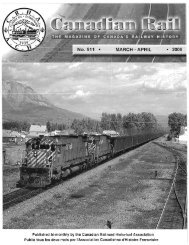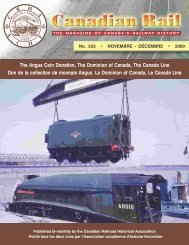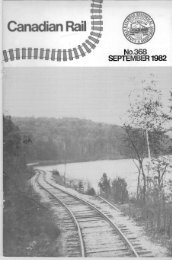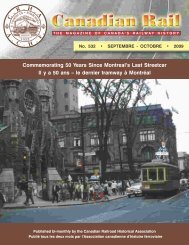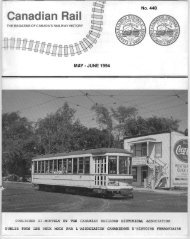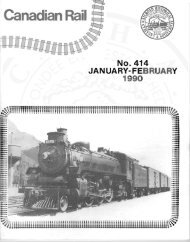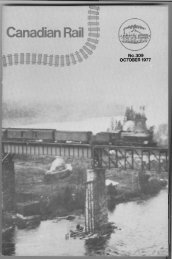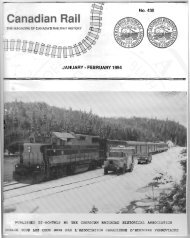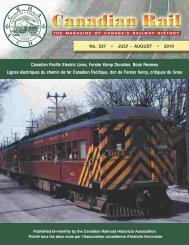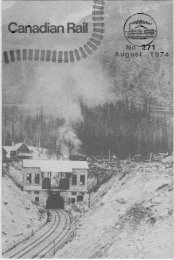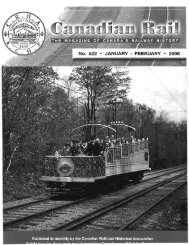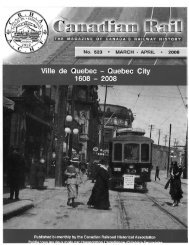Canadian Rail_no538_2010 - Le musée ferroviaire canadien
Canadian Rail_no538_2010 - Le musée ferroviaire canadien
Canadian Rail_no538_2010 - Le musée ferroviaire canadien
Create successful ePaper yourself
Turn your PDF publications into a flip-book with our unique Google optimized e-Paper software.
SEPTEMBER – OCTOBER <strong>2010</strong><br />
233 CANADIAN RAIL • 538<br />
became a constituent company of <strong>Canadian</strong> National<br />
<strong>Rail</strong>ways.<br />
Commuter trains began operating over between<br />
Montreal and St Hyacinthe sometime between 1879 and<br />
1882. A schedule from 1882 shows a train leaving St.<br />
Hyacinthe at 0725 and, after making seven stops, arriving<br />
in Montreal at 0850. In the afternoon the train departed<br />
Montreal at 1710 and pulled into St. Hyacinthe at 1845.<br />
Intercity trains making many of the same stops<br />
supplemented the local commuter train. In May 1893,<br />
these included two Montreal-Sherbrooke-Island Pond,<br />
Vermont and two Montreal-Portland, Maine round trips.<br />
By 1900 six trains stopped at St. Hilaire, including three<br />
operated by the Intercolonial <strong>Rail</strong>way that had running<br />
rights over the St. Rosalie-Montreal track. The eastern<br />
terminus of the commuter train was moved to St. Rosalie<br />
sometime prior to 1910 At St. Rosalie, there was a large<br />
roundhouse to service the steam locomotives and<br />
bunkhouse for train crews. There were some cut backs<br />
during World War I, but service was later restored and<br />
expanded.<br />
Commuter service was well established by the<br />
time the GTR was absorbed by <strong>Canadian</strong> National. The<br />
CN timetable of May 13, 1923 maintains the same level of<br />
service previously provided by the Grand Trunk.<br />
Generally speaking, the commuter trains ran out<br />
along the double track main line through the towns of St.<br />
Lambert, St. Hubert, St. Bruno, St. Basile le Grand,<br />
Beloeil, Otterburn Park, St. Hilaire, Ste. Madeleine, St.<br />
Hyacinthe to Ste. Rosalie. Early in the 1940s, an<br />
additional Montreal-Ste. Rosalie commuter train was<br />
added. This service was maintained up to 1957 when the<br />
second commuter train was discontinued as the effects of<br />
the automobile began to take its toll on railway passenger<br />
traffic. By October 1960, only the commuter train and<br />
one of the Montreal-Sherbrooke trains stopped at St.<br />
Hilaire.<br />
During the steam era, and after the opening of<br />
Central Station in 1943, the trains were pulled by electric<br />
haulers between Central and Bridge Street, as steam<br />
engines were not permitted into Central Station.<br />
Dieselization of the commuter service started in the<br />
spring of 1957 when the ex-Central Vermont RS-3 units,<br />
3900 & 3901, were assigned to locals. Before commercial<br />
navigation ceased along the Lachine Canal, the trains<br />
were subjected to the occasional delay at Lift Bridge when<br />
lake boats would pass by. This was most frustrating in the<br />
morning for commuters who were expected to be at work<br />
for a specific time.<br />
Starting in 1964, CN revised the operation so as<br />
to eliminate the need to overnight equipment and crews<br />
at Ste. Rosalie. The equipment made a deadhead move<br />
from the Montreal coach yard to St. Hyacinthe for the<br />
morning commuter run into Montreal. Similarly, when<br />
the evening commuter arrived at St. Hyacinthe, it would<br />
Puis, en 1923, le GTR devint une constituante du<br />
<strong>Canadian</strong> National <strong>Rail</strong>ways (CNR).<br />
<strong>Le</strong> service de trains de banlieue entre Montréal<br />
et Saint-Hyacinthe débuta entre les années 1879 et 1882.<br />
En 1882, l’horaire indiquait un départ vers Saint-<br />
Hyacinthe à 7 h 25, puis, après sept arrêts, l’arrivée à<br />
Montréal à 8 h 50. En fin d’après-midi, le train quittait<br />
Montréal à 17 h 10 pour arriver à Saint-Hyacinthe à 18 h<br />
45. Des trains interurbains, qui faisaient les mêmes<br />
arrêts, ajoutaient un service complémentaire aux trains<br />
de banlieue. En mai 1893, ceux-ci offraient deux allersretours<br />
entre Montréal, Sherbrooke et Island Pond au<br />
Vermont ainsi que deux allers-retours entre Montréal et<br />
Portland dans le Maine. En 1900, six trains s’arrêtaient à<br />
Saint-Hilaire, dont trois convois de l’Intercolonial<br />
<strong>Rail</strong>way; ce dernier détenait un droit de passage entre<br />
Montréal et Sainte-Rosalie. Vers 1910, le terminus en<br />
direction est de la ligne fut déplacé jusqu’à Sainte-<br />
Rosalie. On y trouvait alors une grande rotonde pour les<br />
locomotives à vapeur et un bâtiment-dortoir pour les<br />
équipes de train. Il y eut des coupures de service pendant<br />
la Première Guerre, mais le service fut par la suite rétabli<br />
et même amélioré.<br />
<strong>Le</strong> service de trains de banlieue du GTR était<br />
déjà bien établi lorsque ce chemin de fer fut absorbé par le<br />
CNR. D’ailleurs, on constate, dans l’horaire en vigueur le<br />
13 mai 1923, que le CNR a maintenu le même niveau de<br />
service qu’offrait auparavant le GTR.<br />
<strong>Le</strong> train de banlieue roulait sur deux voies<br />
principales en passant par les villes de Saint-Lambert,<br />
Saint-Hubert, Saint-Bruno, Saint-Basile-le-Grand,<br />
Belœil, Otterburn Park, Saint-Hilaire, Sainte-Madeleine,<br />
Saint-Hyacinthe et finalement Sainte-Rosalie. Au début<br />
des années 1940, on ajouta un train de banlieue<br />
supplémentaire entre Montréal et Sainte-Rosalie. Ce<br />
service fut maintenu jusqu’en 1957, puis on abolit le train<br />
supplémentaire, une conséquence de la popularité de<br />
l’automobile privée pour le transport des personnes. À<br />
partir d’octobre 1960, un seul train de banlieue et un seul<br />
des trains entre Montréal et Sherbrooke s’arrêtèrent<br />
dorénavant à Saint-Hilaire.<br />
Pendant l’époque de la vapeur et après<br />
l’ouverture de la gare Centrale en 1943, les trains étaient<br />
remorqués par des engins électriques jusqu’à la rue<br />
Bridge, car les locomotives à vapeur n’étaient pas<br />
admises à l’intérieur de la gare.<br />
La conversion au diesel des trains de banlieue<br />
débuta au printemps 1957 lorsqu’on y assigna les<br />
locomotives RS-3 nos 3900 et 3901 acquises du Central<br />
Vermont. Avant la fermeture du canal Lachine, les trains<br />
étaient sujets à certains délais occasionnés par l’élévation<br />
du pont permettant aux navires de circuler. C’était là un<br />
irritant pour les banlieusards, qui espéraient arriver à<br />
l’heure au travail.<br />
En 1964, le CN révisa ses opérations afin



